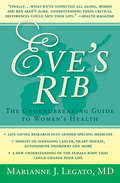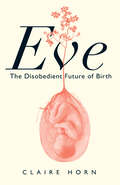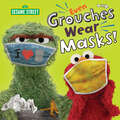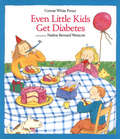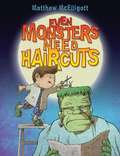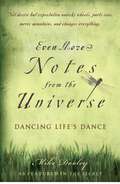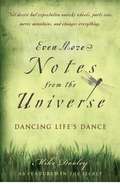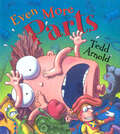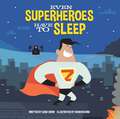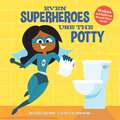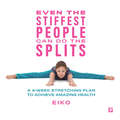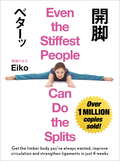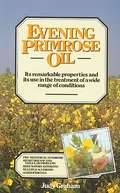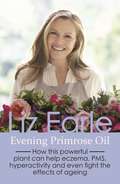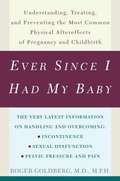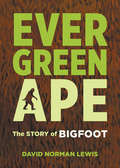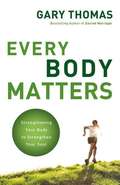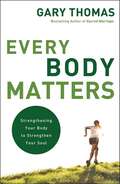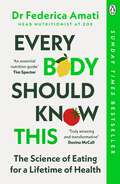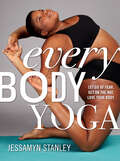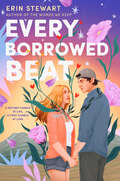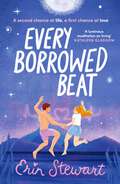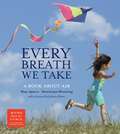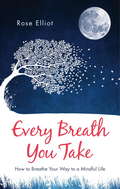- Table View
- List View
Eve's Rib: The Groundbreaking Guide to Women's Health
by Marianne J. LegatoFor decades, medicine saw men and women as essentially the same physically except in the area of reproduction. However, a new and groundbreaking science of gender-specific medicine has discovered astonishing distinctions between male and female bodies. From the thickness of our skin to the signs of a heart attack to ways we metabolize drugs, the sexes have significant physiological differences. But, what do these differences mean to you and your doctor?In this groundbreaking book, internationally respected academic physician and lecturer, Dr. Marianne Legato pulls together more than a decade of research into sex-specific health. The result is a powerful tool for anyone interested in the critical nuances in the ways men and women might present symptoms or be treated for disease. It&’s a book that will not only change the way you think about women&’s health, it just might save your life.
Eve: The Disobedient Future of Birth
by Claire HornA radical interrogation of the ethics and future of birth by an expert legal scholar. Every single one of us has been born from a person. So far. But that is about to change. For the first time, babies could be gestated and born from machines through “Ex-vivo Uterine Environment Therapy,” aka EVE. But such radical technology leaves us with complex legal, social, and ethical questions. What does this breakthrough in artificial human gestation mean for motherhood, womanhood, and parenthood? Countries and people that do not respect the autonomy of pregnant people may use these technologies to curtail choice further, advance eugenic ideas, or to deepen class and racial divides. In this fascinating story of modern birth, Claire Horn takes us on a journey from the first orchid-like incubators in the 1880s to the cutting-edge scientific breakthroughs of today. As she explores the most challenging and pertinent questions of our age, Horn reflects on her own pregnancy. Could artificial wombs allow women to redistribute the work of gestating? How do we protect reproductive and abortion rights? And who exactly gets access to this technology, in our vastly unequal world?
Even Grouches Wear Masks! (Pictureback(R))
by Andrea Posner-SanchezElmo and his Sesame Street friends know how important it is for everyone to wear a mask--even Oscar the Grouch--in this timely paperback with photos of everyone's favorite muppets!Thanks to Elmo, Oscar, Abby Cadabby, Cookie Monster, and their Sesame Street friends, young boys and girls will learn how and why to wear a face mask. Sesame Street fans will love the bright, colorful photos of the lovable muppets wearing masks throughout this paperback book. And they'll laugh while they're learning how to stay healthy--and keep their friends and family healthy, too.Sesame Workshop, the nonprofit educational organization behind Sesame Street, aims to help kids grow smarter, stronger, and kinder through its many unique domestic and international initiatives. These projects cover a wide array of topics for families around the world.
Even Little Kids Get Diabetes
by Nadine Bernard Westcott Connie PirnerEasy language and simple explanations will help even very young children understand what it means to have diabetes. They will find some of their own experiences described and at the same time receive reassurance that they are still "regular kids."
Even Little Kids Get Diabetes
by Connie White PirnerA young girl tells of how she was diagnosed with diabetes and what it means for her and her family.
Even Monsters Need Haircuts
by Matthew McElligottAt night under a full moon, a child operates a barber shop with a monstrous clientele.
Even More Notes From the Universe: Dancing Life's Dance
by Mike DooleyThe Universe -- our eternal partner -- returns for the third installment in the Notes from the Universe series, dispensing wisdom, humor, and insight into the truth about creating the future we desire. Even More Notes from the Universe combines Mike Dooley's pithy and inspiring messages, direct from the Universe, to help you start living the life of your dreams -- today. Focusing on the desired results joyfully and with gratitude is infinitely more engaging than struggling and stressing about them. Relax, laugh, and enjoy the footwork the Universe has to share. Whether your dance is the tango, hula, or one of your own creation, dancing life's dance begins with that first brave step. The music has always been playing your favorite tune, yet hearing it requires action. And right on cue, your unfailing partner, the Universe, begins choreographing players and events in a waltz of miracles, moving heaven and earth to align the future of your dreams with your present circumstances. Nothing is impractical, impossible, or out of reach. Your thoughts create worlds, your words shape the future, and the steps you take unleash the magic behind creation. In this third book in the Notes from the Universe trilogy, Mike Dooley brings a fresh perspective from your most loyal friend.
Even More Notes from the Universe
by Mike DooleyProminent contributor to The Secret, Mike Dooley offers more insightful, entertaining messages to amuse and inspire you. While the first book spoke primarily about new beginnings, and the second book's focus was about traditions, Even More Notes from the Universe speaks on the theme of change, growth and decision-making. Many of the notes echo the overarching theme of personal empowerment, giving readers the help from the cosmos that most of us have needed at one point or another. But throughout the third book, Mike Dooley shares his philosophy of change - when you come to the point in your life where you have a choice between doing what you want to do, and what you have to do, always do what you want, he says. What started in 1998 as a little poem sent out once a week to a handful of email addresses has evolved into an inspiring anecdote delivered to over 150,000 subscribers from 169 countries. Mike Dooley serves as an interpreter for the Universe. Notes from the Universe: Book 3 is the third and final book in the three-volume set that is brimful with powerful affirmations that will have you thinking positively, feeling confident, and walking the path to personal success. When readers discover the truths the Universe is unveiling, they will begin living happier, more fulfilling lives.
Even More Parts
by Tedd ArnoldChip Block, the hero of Parts, is back, and still worried about falling apart based on the things he hears. This time he's made a list of all the strange, crazy things he's heard people say: "I lost my head." "My nose is running." "I sang my heart out. . . ." It's scary stuff, but he has a plan for making sure he doesn't accidentally leave any of his parts behind. A hilarious sequel to the wildly popular Parts and More Parts.
Even Superheroes Have to Sleep
by Sara Crow&“Will ease little readers to restful states.&”—KirkusToddlers will feel better about bedtime when they learn that superheroes, cowboys, princesses, and astronauts ALL have to sleep too! It&’s bedtime for superheroes . . . and KIDS! Young ones will enjoy this sweet, short rhyming story that lulls them into bedtime with the promise that all their heroes are getting tucked into bed too. And the book comes with stickers and a reward chart, so good bedtime habits can be reinforced each night when kids brush their teeth, put on their pj&’s, and settle down to sleep. It&’s a book and sticker package that will help parents achieve bedtime peace each night.And don't miss the companion book—Even Superheroes Use the Potty—to help teach kids good bathroom habits.
Even Superheroes Use the Potty
by Sara Crow"A potty-training book to go for."—Kirkus ReviewsIt&’s potty time for superheroes, firefighters, ninjas, soldiers, and KIDS! Young ones will enjoy this funny, rhyming story that teaches great bathroom habits with the promise that all their heroes use the potty too. And the book comes with stickers and a bathroom reward chart, so good potty habits can be celebrated each time kids put the lid down, flush, and wash their hands! It&’s a book-and-sticker package that will help parents achieve toilet-training harmony. And don&’t miss the companion book—Even Superheroes Have to Sleep!—to help restless kids settle in at night.
Even the Stiffest People Can Do the Splits: A 4-Week Stretching Plan to Achieve Amazing Health
by EikoExperience amazing health benefits by learning how to do the splits in just 4 weeks! Whether you spend your days running marathons or slouching over a keyboard, everyone can benefit from stretching and the increased flexibility that comes along with it. With only five minutes of stretching a day, you’ll be doing perfect splits in four weeks and experiencing a host of health benefits such as better circulation, fewer joint injuries, toned muscles, improved balance, and much more! With world-renowned yoga teacher Eiko’s revolutionary program, people of any age and fitness level can say goodbye to those mysterious aches and pains that are caused by stiff, contracting muscles, and see unbelievable results. All you need is this book, two legs, and a floor, and you're on your way to doing the splits!
Even the Stiffest People Can Do the Splits: Get the limber body you've always wanted, prevent injury and improve circulation in just four weeks
by EikoOver 1 million copies sold in Japan!Young, old, made of rubber or rusty metal, anybody can do the splits. Eiko, a yoga instructor from Japan, teaches you how in just four weeks and you can achieve dramatic health benefits in the process. Most people wish they could be more flexible, or even just feel better as they get out of bed every morning. Doing the splits is seen as the epitome of flexibility, but it also has previously unrecognized, often dramatic health benefits:- Gain better circulation- Reduce the risk of joint injuries and lower back pain- Enjoy better balance - Tighten your stomach muscles and tone the legs - Improve overall flexibilitySo how does it work? You will start by doing two of the basic stretches every day. Then, add one new stretch to that routine every week thereafter. The routine takes no more than five minutes a day, and in just four weeks you'll be doing a perfect splits! Some people will get it sooner, others may take a little bit longer but EVERYBODY can do the splits with Eiko's help.
Evening Primrose Oil
by Judy GrahamHere is the story of the remarkable evening primrose, and the uses to which the oil from its seeds can be put--one of the major ones being in the treatment of premenstrual tension. It is a story which could turn out to be one of the most fantastic in plant history. Like foxglove (digitalis), cinchona bark (quinine) and rauwolfia (reserpine) it promises to take its place in the hall of fame of plants and herbs with important medicinal properties. But, unlike these other natural products which are on the whole useful for one condition only, the oil of the evening primrose has properties which make it useful for a wide range of conditions
Evening Primrose Oil: How this powerful plant can help eczema, PMS, hyperactivity and even fight the effects of ageing (Wellbeing Quick Guides)
by Liz EarleLiz Earle explores the properties of one of Britain's favourite herbal medicines and explains how it can boost your health and wellbeing today.Bestselling beauty and wellbeing writer Liz Earle's fully revised and updated quick guide to evening primrose oil, including:- An introduction to evening primrose oil and the science behind its health-giving properties - How to incorporate evening primrose oil into your skincare regime- The effect of evening primrose oil on ailments including PMS for women and hyperactivity in children- A practical guide to buying supplements, plus dosage for all the family
Ever Since I Had My Baby
by Roger Goldberg"Now women have it all--a much-needed book covering an undiscussed part of women's health, a book that beautifully explains the common and distressing problems of prolapse and incontinence. Finally, a woman can have the facts and options to make her a team player with her physician as she tackles these issues. The information in this book picks up where that in What to Expect® When You're Expecting leaves off."--Elizabeth G. Stewart, M.D., author of The V BookAt last, a reassuring, straightforward, and practical guide to easing, preventing, and even curing, once and for all, the symptoms of pelvic-floor disorders, including:*incontinence *prolapse *pressure and pain *sexual difficulties *bowel troubles Pelvic-floor disorders are much more common than you might think--millions of women suffer from one or more symptoms of pelvic-floor injury. These problems often stem from the strain placed on the body during pregnancy and childbirth, although symptoms may take years, or decades, to appear--if they don't begin right away. Childbirth can wreak havoc on even the healthiest woman's body, and you may still be feeling the effects long after the birth of your last child. If you suffer from any of these conditions, you do not need to feel helpless, and you are certainly not alone. Every one of these pelvic disorders is treatable, even curable in many cases. Dr. Roger Goldberg, a respected physician in the emerging field of urogynecology, provides the most up-to-date information on surgical and nonsurgical treatment options. He offers a clear explanation of the pelvic anatomy and why these disorders occur and also describes simple preventive techniques you can use to ease pelvic symptoms and minimize further strain (including the correct way to do Kegel exercises). Armed with the facts and candid advice contained in Ever Since I Had My Baby, you will be able to discuss your individual symptoms and potential treatments with your doctor confidently and knowledgeably. This book will help you realize the freedom you've been seeking from the emotional and physical burden of symptoms that often go unmentioned, or are overlooked, in women's health care.From the Trade Paperback edition.
Evergreen Ape: The Story of Bigfoot
by David Norman LewisThe Pacific Northwest has always been home to unusual folktales, bizarre legends, and strange goings ons. From the countless UFO sightings and the dense rainforests of Oregon and Washington, to the sprawling network of Shanghai tunnels interlaced beneath the cities, the region is rife with stories of the unexplained and the unnatural. In Evergreen Ape, David Lewis takes a closer look at the origins of the Pacific Northwest&’s most beloved and elusive cryptid: Bigfoot. Drawing from newspaper reports, local American Indian legends, and stories passed down from settlers in the 1800s, Lewis explores the true stories that created the modern monster. Discover the various manifestations of the legend and the way he has interacted with society, then read about popular hikes in the area where he has supposedly been spotted, and step onto the path of finding Bigfoot yourself.
Every Body Matters: Strengthening Your Body To Strengthen Your Soul
by Gary ThomasFew pastors or Christian writers have dared to approach the subject of how proper eating and an active lifestyle can affect how we serve God. Author Gary Thomas does just that. And he reaches all the way back to the apostle Paul, who wrote that we need to prime our bodies to become, "an instrument for noble purposes, made holy, useful to the Master and prepared to do any good work. " To illustrate the body/soul correlation, Thomas presents engaging and diverse stories that include a young mom who got fit through volleyball and reaped spiritual rewards in her marriage, a 300-pound pastor who realized his obesity was eroding his ministry impact, and a woman who gained the spiritual strength to survive a contentious divorce by training for a marathon. In every instance, Thomas makes a direct connection between the physical challenge and its spiritual consequence. This book is a must read for anyone seeking new and compelling motivation for strengthening their bodies and fortifying their souls. Visit http://www. youtube. com/watch?v=uOJVmFwlYbA for more.
Every Body Matters: Strengthening Your Body to Strengthen Your Soul
by Gary ThomasFew pastors or Christian writers have dared to approach the subject of how proper eating and an active lifestyle can affect how we serve God. Author Gary Thomas does just that. And he reaches all the way back to the apostle Paul, who wrote that we need to prime our bodies to become, "an instrument for noble purposes, made holy, useful to the Master and prepared to do any good work." To illustrate the body/soul correlation, Thomas presents engaging and diverse stories that include a young mom who got fit through volleyball and reaped spiritual rewards in her marriage, a 300-pound pastor who realized his obesity was eroding his ministry impact, and a woman who gained the spiritual strength to survive a contentious divorce by training for a marathon. In every instance, Thomas makes a direct connection between the physical challenge and its spiritual consequence.This book is a must read for anyone seeking new and compelling motivation for strengthening their bodies and fortifying their souls.
Every Body Should Know This: The Science of Eating for a Lifetime of Health (From Medical Scientist and Head Nutritionist at ZOE)
by Dr Federica Amati***AS SEEN ON THIS MORNING***CHANGE YOUR APPROACH TO EATING IN 2025 FOR A LIFETIME OF HEALTH‘An essential nutrition and lifestyle guide across the lifespan. A fascinating DIY guide to food and health – read it!’ Dr Tim Spector, author of Spoon Fed and Food for Life‘This book contains the most critical answers to nutrition that we’ve all been searching for. A must read’ Steven Bartlett'Truly amazing and completely transformative’ Davina McCall----A SCIENCE-BACKED NUTRITION GUIDE FOR ALL LIFE STAGESIn Every Body Should Know This, medical scientist and Head Nutritionist at ZOE, Dr Federica Amati explores the real science behind nutrition. By following her advice, you will learn how to eat for best health at each life stage and discover what every body should know, such as . . .- The truth surrounding superfoods and ultra-processed foods- Why nutrition plays a crucial role from before conception to senior years- How food choices can support longevity- Targeted tips for good health at each life stageWith this book, you will gain insights into what foods work for the bodies and minds of you and your loved ones, and implement clear, nutritional strategies backed by the latest scientific research for men, women and children.Because when it comes to food, one size does not fit all.----'A definitive guide on not just what to eat, but when and why' Daily Telegraph'So good, so informative. There's so much incredible stuff in here' Cat Deeley and Ben Shepherd, This Morning‘An easy to implement and practical guide to nutritional science!’ Dr Karan Rajan, author of This Book Will Save Your Life‘Federica offers a novel framework for thinking about nutrition and points to the lifestyle factors that do make a difference in protecting and enhancing our long-term health. This is a book you shouldn’t miss’ Dr Sarah Berry
Every Body Yoga: Let Go of Fear, Get On the Mat, Love Your Body.
by Jessamyn StanleyFrom the unforgettable teacher Jessamyn Stanley comes Every Body Yoga, a book that breaks all the stereotypes. It’s a book of inspiration for beginners of all shapes and sizes: If Jessamyn could transcend these emotional and physical barriers, so can we. It’s a book for readers already doing yoga, looking to refresh their practice or find new ways to stay motivated. It’s a how-to book: Here are easy-to-follow directions to 50 basic yoga poses and 10 sequences to practice at home, all photographed in full color. It’s a book that challenges the larger issues of body acceptance and the meaning of beauty. Most of all, it’s a book that changes the paradigm, showing us that yoga isn’t about how one looks, but how one feels, with yoga sequences like “I Want to Energize My Spirit,” “I Need to Release Fear,” “I Want to Love Myself.” Jessamyn Stanley, a yogi who breaks all the stereotypes, has built a life as an internationally recognized yoga teacher and award-winning Instagram star by combining a deep understanding for yoga with a willingness to share her personal struggles in a way that touches everyone who comes to know her. Now she brings her body-positive, emotionally uplifting approach to yoga in a book that will help every reader discover the power of yoga and how to weave it seamlessly into his or her life.
Every Borrowed Beat
by Erin StewartA romance that takes an unflinching look at not only the realities of heart failure, but at memory, grief, guilt, and what it means to live—in a "poignant yet funny" (Booklist) read that's "alternately heart-wrenching and heartwarming" (Kirkus)--from the award-winning author of The Words We Keep What if the heart that saved your life also held the secrets of another's?* "With its perfect blend of chronic illness representation, mental health exploration, and romance, this is sure to appeal to fans of books like John Green&’s The Fault in Our Stars . . . a standout addition to the genre."--SLJ, starred reviewSydney Wells should have died. She was supposed to die.She never expected, after years of waiting, to receive a heart transplant. Now, seventeen-year-old Sydney doesn&’t know what to do with her life. Her daily routine consisted of staying indoors, eating heart-healthy foods, and posting about her transplant list experiences on TheWaitingList with her long-distance BFF (and heart failure buddy) Chloe. Now, Sydney latches onto the one thing that gives her meaning: learning as much as she can about the person whose heart she inherited. After finding the family of her likely-donor, Mia, Sydney falls deep into her world—and may also be falling for Mia's best friend, Clayton. But Sydney isn&’t the only one hiding something. Mia&’s brother Tanner won&’t talk to Clayton, and Clayton won&’t tell Sydney why. And hundreds of miles away, Chloe&’s health has taken a turn for the worse. Sydney needs to face what&’s in her heart—the truth, the guilt, and the future—before it&’s too late.
Every Borrowed Beat
by Erin StewartA second chance at life, a first chance at love. 'A luminous, brilliant meditation on living that will burrow deep into your heart and stay there... An emotional and riveting must-read.' Kathleen Glasgow, bestselling author of Girl in Pieces Sydney Wells should have died. She was supposed to die. But after years of waiting, she has been given a new heart. Her only job is not to break it. Still, she can&’t help thinking about how her second chance means that someone else&’s life was cut short. After some detective work, Sydney concludes that her donor was a girl called Mia who died tragically in a nearby town. Desperate for closure, she attends her memorial service, where she meets Mia&’s best friend Clayton: a boy who makes her new heart race... 'Devastating, funny, and heartwarming all at once, Every Borrowed Beat had me gasping for breath with every page.' Anika Hussain, author of This is How You Fall in Love
Every Breath We Take: A Book About Air
by Dominique Browning Maya AjmeraClean air is essential for all living creatures—plants, animals, and people—to live healthy lives. Every Breath We Take is a positive, life-affirming look at clean air, with a subtle message about how air can be dirtied—and how it can be cleaned up. Photographs of beautiful children around the world exploring air through touch, smell, sound, and sight underscore the importance of clean air to all life on earth. This is science that surrounds us.The first step to cherishing something is recognizing its importance and understanding why it is necessary. A portion of the proceeds from the sales of this book will be donated to Moms Clean Air Force, a national movement of over a half million moms, dads, and grandparents who are protecting the right of every child to breathe clean air.
Every Breath You Take: How to Breathe Your Way to a Mindful Life
by Rose ElliotMindful breathing is direct, natural and easy to learn, it is simply using your breath as a focus or a tool for mindfulness. If you can breathe you can be mindful and once you master this you can access it at any point, wherever you are day or night. Mindful breathing can help you to: * Gain an immediate sense of peace - this can be experienced from the first breath * Helps you accept yourself, other people, and your life, just as they are without fighting against them * Connect to your own inner strength * Achieve an inner sense of well-being, energy, and joy * Be kinder to yourself and to others Following on from the hugely successful I Met A Monk, Rose Elliot, renowned vegetarian chef and proponent of mindfulness gently leads the reader on a journey that starts with the teachings of the Buddha on a moonlit evening. In its re-telling she reveals the techniques and teachings of the Buddha, that are as valid today as they were two and a half thousand years ago on mindful breathing. Every Breath You Take brings a fresh approach to mindfulness that will inspire anyone who hasn't tried it and will bring new life to the practice of those who have. Both practical, personal and inspirational this book will give you the tools and exercises you need to be able to understand and use mindful breathing every day of your life.
